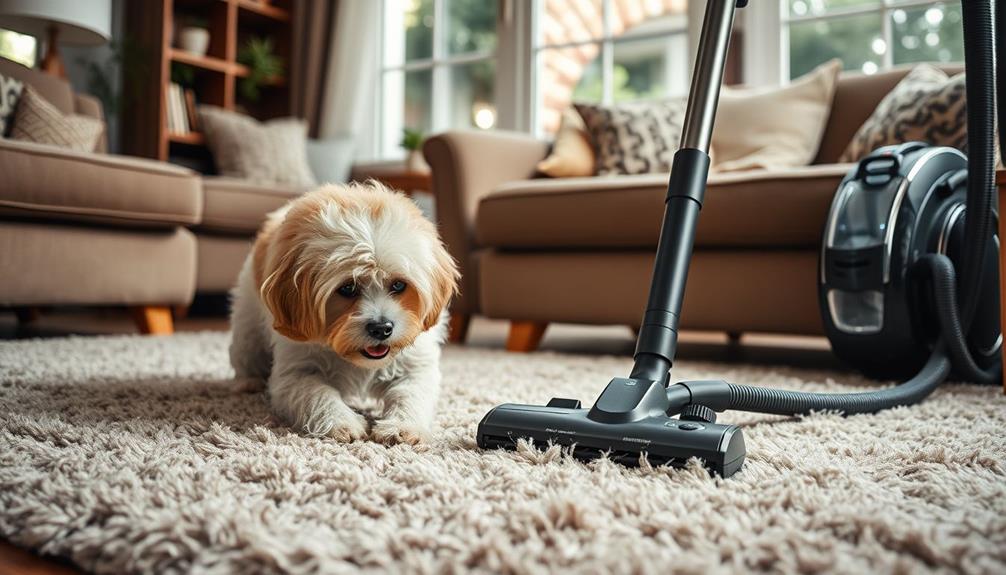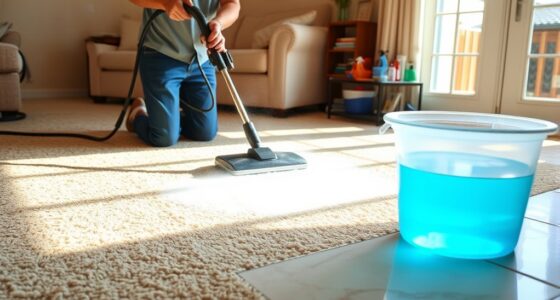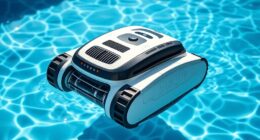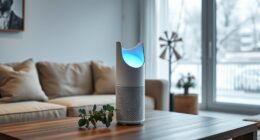When selecting the best vacuum for pet hair, it is important to focus on specific features that will improve cleaning effectiveness. It is essential to look for strong suction power to effectively remove stubborn fur from carpets and upholstery. Anti-tangle technology can help prevent hair wrapping around the vacuum, while HEPA filters can capture allergens and enhance indoor air quality. A lightweight design will allow for easy maneuvering in small spaces. It is also beneficial to consider attachments such as motorized brushes and crevice tools for reaching difficult areas. Additionally, opting for a model with a mess-free dust bin can simplify the cleaning process. Discover more helpful tips to assist in making the right choice for your home.
Key Takeaways
- Look for strong suction power to effectively lift stubborn pet hair from carpets and upholstery.
- Choose vacuums with HEPA filters to capture allergens and improve indoor air quality.
- Opt for models with anti-tangle technology to minimize hair wrap around brush rolls.
- Select versatile attachments, like motorized brushes, to enhance cleaning efficiency in tricky areas.
- Consider lightweight designs for better maneuverability and ease of use in tight spaces.
Importance of Effective Vacuuming
Effective vacuuming is essential for every pet owner. With pets around, managing the accumulation of pet hair becomes a regular task, and you should aim to vacuum at least once a week to keep your home clean.
Pet hair can easily embed itself in carpets and upholstery, making it imperative to have a vacuum designed for deep cleaning and hair removal. Look for vacuums with strong suction power, as they capture more hair and dander effectively. For instance, models like the Bissell Pet Hair Eraser Vacuum feature enhanced suction power specifically for effective hair removal.
HEPA filters are also essential since they trap allergens, improving your indoor air quality. A lightweight and maneuverable vacuum makes it easier to clean various surfaces, including those hard-to-reach areas where pet hair tends to hide.
Regular maintenance is key to sustaining your vacuum's performance, especially in homes with pets. Clean the filters and replace bags as needed to guarantee your vacuum continues to work at its best.
Essential Features for Pet Hair
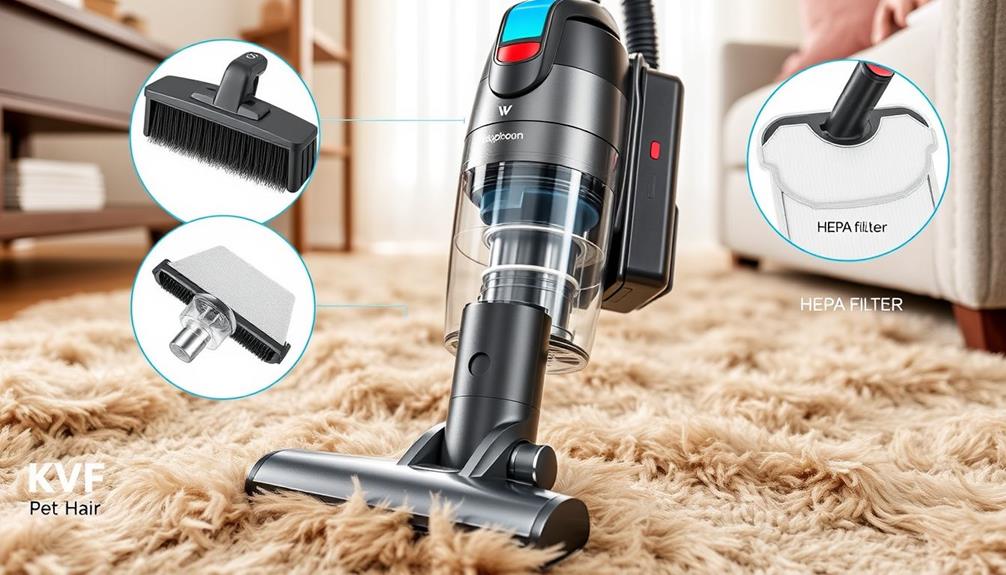
When it comes to vacuuming up pet hair, having the right features in your vacuum makes all the difference. First, focus on suction power; you need a vacuum that effectively removes pet hair from various surfaces. A strong suction capability prevents hair accumulation and guarantees thorough cleaning performance.
Additionally, consider vacuums specifically designed for pet hair, as they often include features like anti-tangle technology that help manage stubborn fur.
Next, consider the filtration system. Vacuums with a HEPA filter capture 99% of particles down to 0.3 microns, trapping allergens and pet dander, which is especially important for allergy sufferers.
Look for tangle-resistant features, like specialized brush rolls that minimize hair wrap, making maintenance a breeze.
Versatile attachments, such as motorized brushes and crevice tools, are essential for enhancing cleaning efficiency on furniture and those hard-to-reach spots.
Types of Vacuums for Pets
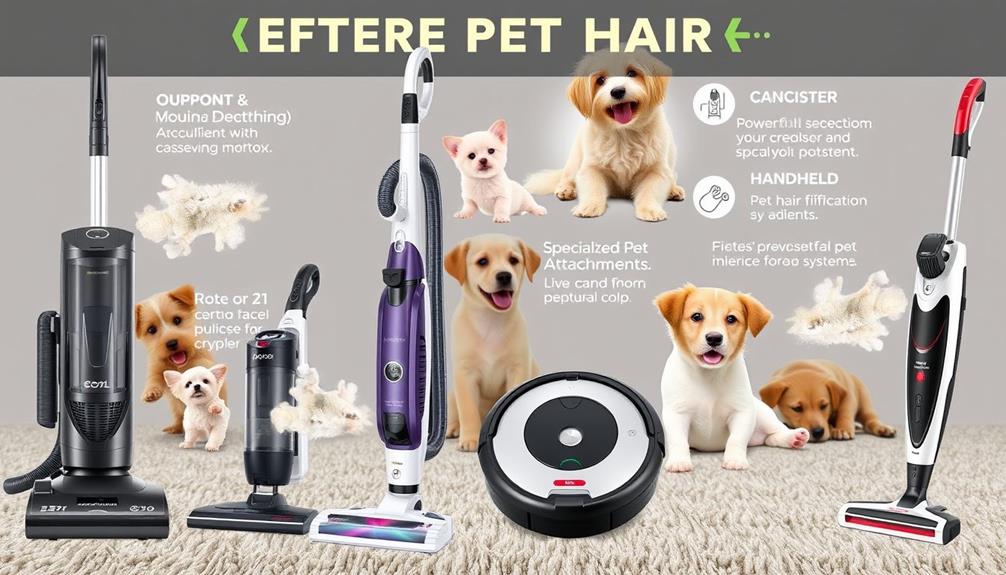
Several types of vacuums cater specifically to pet owners, each designed to tackle the unique challenges of pet hair. An upright vacuum for pet hair, like the Shark ZU62 Navigator, offers powerful suction and is ideal for deep cleaning carpets.
If you prefer something lightweight and easy to maneuver, a canister vacuum, such as the Kenmore Pet-Friendly model, features a motorized brush to handle both carpets and hard floors effectively. Many of these vacuums also come with advanced features, similar to enhanced home security options found in garage door openers, ensuring thorough cleaning.
For quick clean-ups, cordless stick vacuums like the Dyson V15 Detect are a great option, weighing just 6.8 pounds and providing up to 60 minutes of battery life.
Handheld vacuums, such as the Black + Decker Furbuster, are perfect for spot cleaning; they come with tangle-resistant rubber bristles that tackle pet hair without getting tangled.
Lastly, consider a robot vacuum like the iRobot Roomba J7+, which uses smart-mapping technology and boasts an easy-to-empty feature, making it a low-maintenance choice for continuous pet hair removal.
Each of these vacuums provides unique benefits tailored to the needs of pet owners.
Performance Evaluation Criteria
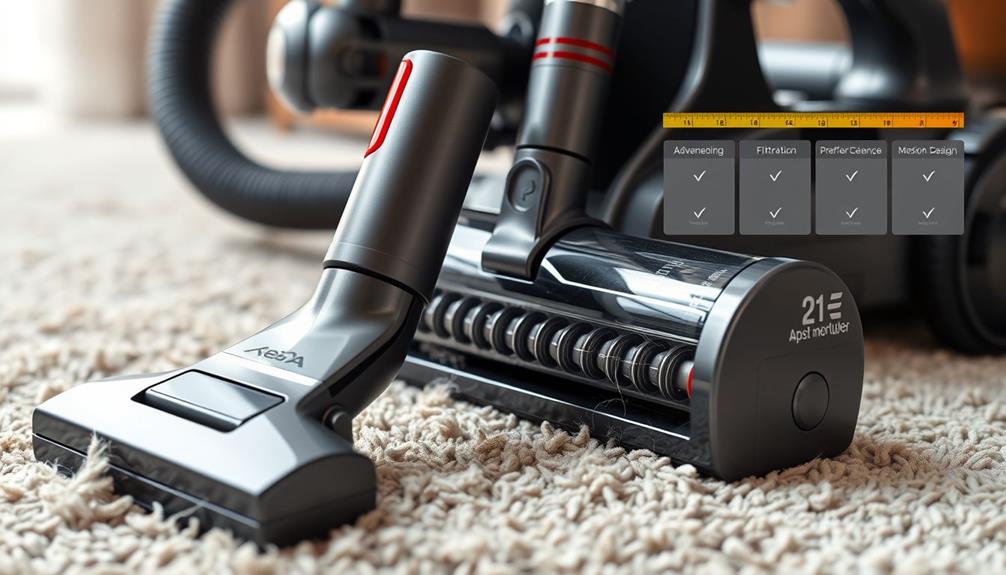
Evaluating a vacuum for pet hair involves several key performance criteria that can make a significant difference in your cleaning experience. When shopping for an effective model, consider the following factors:
| Criteria | Importance | Recommendations |
|---|---|---|
| Suction Power | Essential for removing pet hair | Look for strong performance on carpets and hardwood |
| Maneuverability | Aids ease of use in tight spaces | Choose lightweight designs with swivel heads |
| Dust Bin Management | Impacts convenience during cleaning | Opt for models with mess-free emptying systems |
| Noise Levels | Affects your cleaning comfort | Quieter models (62-66 decibels) are preferred |
| Filtration | Captures allergens and pet dander | HEPA filters guarantee better air quality |
Expert Recommendations and Insights
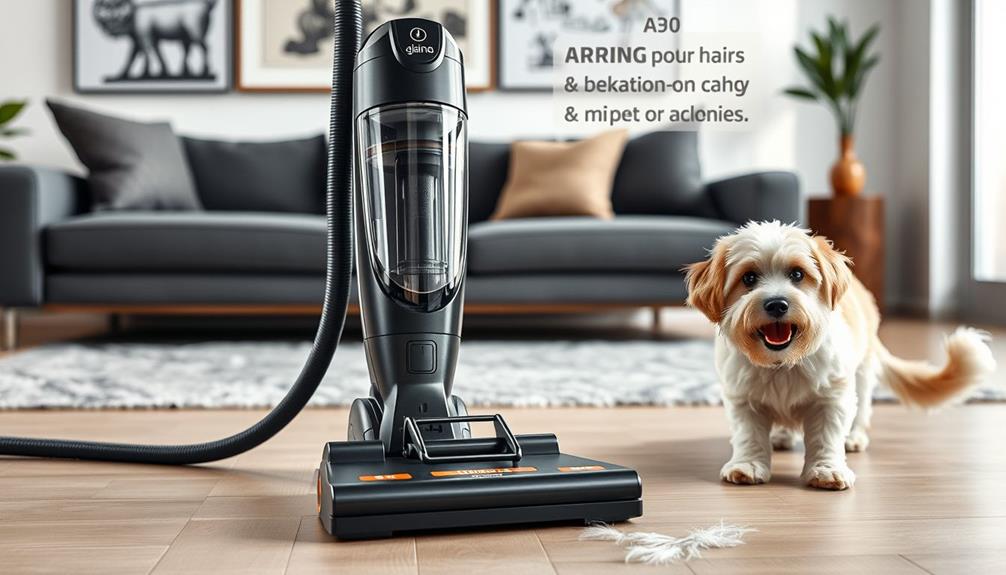
Finding the right vacuum for pet hair isn't just about meeting basic performance criteria; it's also about understanding which features can truly enhance your cleaning routine. Here are some expert recommendations to keep in mind: When searching for the best robotic vacuums for pet hair, consider models with specialized brushes or suction power specifically designed to pick up pet hair and dander. Additionally, look for vacuums with high-efficiency filters to capture allergens and pet hair, as well as models with sensors to avoid getting tangled in pet hair or obstacles. Ultimately, finding the right vacuum for pet hair may require investing in a model with advanced features to ensure a thorough and efficient cleaning routine.
- Strong suction power: Look for vacuums that can easily lift stubborn pet hair from carpets and upholstery. This is essential for maintaining a clean home, especially if you have multiple pets.
- Pet hair attachments: Specialized tools can make a significant difference in your cleaning efficiency, allowing you to reach those tricky spots where hair tends to accumulate. You may also want to reflect on what to look for in a home cleaning service to complement your vacuuming efforts.
- HEPA filters: These filters capture 99% of particles down to 0.3 microns, improving air quality by trapping pet dander and allergens.
- Lightweight designs: A vacuum like the Dyson V15 Detect (6.8 pounds) offers excellent maneuverability, making it easy to transport between rooms.
Additionally, contemplate the vacuum's noise level; quieter models, such as the Black + Decker Furbuster (62-66 decibels), are perfect for homes with sensitive pets.
Don't overlook user-friendly features like easy-to-empty bins and onboard attachment storage, as they enhance the overall cleaning experience. By prioritizing these elements, you'll guarantee your vacuum for pet hair meets both your needs and your furry friend's comfort.
Frequently Asked Questions
What Should I Look for in a Pet Vacuum?
When you're looking for a pet vacuum, focus on strong suction power to tackle embedded hair.
A HEPA filter's essential too, as it captures allergens effectively.
Specialized attachments like pet hair brushes make cleaning easier, while a lightweight design helps you maneuver around tight spots.
Don't forget about noise levels—quieter vacuums can keep your pets calm while you clean.
Consider these factors to find a vacuum that meets your needs.
What Makes a Vacuum Better for Pet Hair?
When you're looking for a vacuum that's better for pet hair, focus on strong suction power and specialized attachments like motorized brushes.
You'll want a model with a HEPA filter to capture allergens and dander, improving air quality.
A lightweight design helps you maneuver around furniture easily, while tangle-resistant brush rolls prevent hair wrap.
What Is the Difference Between a Pet Hair Vacuum and a Regular Vacuum?
Imagine a whirlwind of fur clinging to your furniture and floors. A pet hair vacuum tackles that mess with powerful suction and specialized brush rolls, grabbing every stubborn strand.
Unlike regular vacuums that struggle, these devices feature tangle-resistant designs and advanced HEPA filtration, capturing allergens and dander.
With lightweight and maneuverable builds, you'll glide through your space. Plus, specialized attachments make cleaning tight corners and upholstery a breeze, ensuring your home stays fur-free.
What Specifications to Look for When Buying a Vacuum Cleaner?
When you're buying a vacuum cleaner, focus on a few key specifications.
Look for strong suction power to effectively pick up dirt and debris. A HEPA filter's a great addition for cleaner air.
Consider models with specialized attachments for versatile cleaning. Lightweight and maneuverable designs make it easier to reach tight spots.
Conclusion
In your quest for the perfect vacuum, remember that finding one tailored for pet hair can transform your cleaning routine. Coincidentally, as you explore options with powerful suction, specialized attachments, and allergen filtration, you'll discover a vacuum that not only tames fur but also makes your home feel fresher. With the right choice, you'll enjoy more cuddle time with your furry friend and less time battling pesky hair. Happy vacuuming—you and your pet deserve it!
